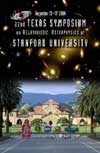Parallel C Talks: Abstracts
View Abstract Summary
0301: Terrestrial Interferometers and Resonant Mass Detectors
Authors: Nergis Mavalvala (MIT)
As the Laser Interferometer Gravitational-wave Observatory (LIGO) and its international counterparts have completed their first scientific data runs, we enter an exciting new era of gravitational-wave astronomy. A description of the present status of terrestrial detectors -- interferometers and resonant mass detectors -- will be followed by highlights of recent results for potential astrophysical sources.
0302: Relativistic Astrophysics and the Laser Interferometer Space Antenna
Authors: E. Sterl Phinney (California Institute of Technology)
The NASA/ESA Laser Interferometer Space Antenna (LISA) mission, planned for launch in 2012 (with a test mission scheduled for 2007). will detect and measure gravitational radiation from astronomical sources at frequencies 0.0001 Hz to 0.1 Hz (compared to 30-1000 Hz for ground-based detectors like LIGO). LISA will detect continuous signals from: thousands of exotic binary stars in the Milky Way, merging supermassive black holes in the nuclei of merging galaxies at redshifts from 0 to 100, and compact stars scattered into supermassive black holes. The latter will provide precision tests of strong-field predictions of relativity, such as the No-Hair Theorem and energy extraction from rotating black holes. We describe the principles of operation of LISA, and highlights of the many science questions it can address.
0303: 35 Years of Lunar Laser Ranging: Implications for Cosmology
Authors: Ken Nordtvedt (Northwest Analysis)
35 Years of laser ranging to the Moon (LLR) has produced 16,000 range measurements. From this data the relativistic lunar orbit is fit at the few millimeters level. Earth and Moon fall toward the Sun at rates equal to 1.3 parts in 10^13, confirming the specific post-Newtonian, non-linearity of pure tensor General Relativity at the part in 10^4 level. The data's long time span permits the most precise constraint on any extant time variation in Newton's G --- dG/Gdt < 10^-12 per year. Any in-plane differential acceleration of Earth and Moon in a fixed cosmic direction is constrained to be less than 10^-14 cm/sec^2. Because Earth and Moon have different compositions, this interestingly limits any cosmic spatial gradient of the fine structure 'constant' which in turn has implications for any models of cosmological time variation of this parameter. A new generation LLR program in New Mexico (APOLLO), employing a larger telescope and a photon detector array, is designed to achieve much higher signal to noise ratio and should push these scientific determinations an additional order of magnitude in the coming years.
0304: The Cassini Solar Conjunction Experiment: A Test of General Relativity using Precision Doppler Tracking of an Interplanetary Spacecraft
Authors: Luciano Iess, Bruno Bertotti, Paolo Tortora
Cassini, the largest planetary mission ever flown, was used for a very accurate test of General Relativity during the cruise to Saturn, its final destination. The experiment was carried out from June 6 to July 5 2002 while the spacecraft was at 8.3 AU heliocentric distance and near solar conjunction, using novel instrumentation developed by NASA/JPL and the Italian Space Agency for the radio science experiments of the mission. The experiment is based on very accurate range-rate measurements (at the level of 1.5 micron/s at 1000-10000 s integration time) and therefore differs from previous tests exploiting either VLBI techniques or ranging tones. Thanks to a dedicated onboard frequency translator and the adoption of a multi-frequency link in X and Ka-band (7.2-8.4 and 32.5-34 GHz), the large plasma noise due to irregularities in the solar corona has been nearly completely cancelled. In addition, the large distance from the sun, the large mass of the spacecraft (more than 5000 kg) and the use of momentum wheels for attitude control resulted in very small and nearly constant non-gravitational accelerations. The orbital solution, fully consistent with General Relativity, uses a simple dynamical model, where non-gravitational accelerations are due only to solar radiation pressure and anisotropic emissions from the onboard radioisotope thermoelectric generators. The parameter gamma (controlling also the deflection of light and the time delay of photons in solar system tests of General Relativity) was found to be 1+(2.1 ± 2.3) x 10^-5 (B.Bertotti, L.Iess, P.Tortora: Nature, 425, p.375, 2003), so far the most accurate confirmation of Einstein’s theory.
0305: Improved Test of General Relativity with Radio Doppler Data from the Cassini Spacecraft
Authors: John D. Anderson (Jet Propulsion Labroatory), Eunice L. Lau (Jet Propulsion Labroatory), Giacomo Giampieri (Imperial College)
Radio Doppler data from the Cassini spacecraft during its solar conjunction in June 2002 can be used to test General Relativity. In terms of the standard post-Newtonian parameter gamma, we find that the mean value of gamma is displaced about one sigma in the negative direction from the value of unity predicted by General Relativity. Our value of sigma, including both random and systematic error, is 60 ppm. This unpublished result will be compared with the published result of Bertotti, Iess, and Tortora (Nature Vol.425, pp.374-376, 2003).
0306: The Laser Astrometric Test Of Relativity (LATOR) Mission
Authors: Slava G. Turyshev (NASA/JPL), Michael Shao, Yekta Gursel, James G. Williams (NASA/JPL), Kenneth L. Nordtvedt, Jr. (Northwest Analysis), Thomas W. Murphy, Jr. (University of California, San Diego)
The Laser Astrometric Test of Relativity (LATOR) mission is a 21st century Michelson-Morley experiment designed to search for presence of a cosmologically-evolved scalar field in the solar system. This new fundamental physics experiment is designed to test relativistic gravity at an accuracy never achieved before – probing for the first time second-order effects in the gravitational field strength. As such, LATOR will improve the current accuracy in the tests of general relativity by a factor of 3,000 reaching an accuracy of one part in 108 in measuring space-time curvature (as parameterized by the Eddington parameter gamma). The LATOR mission uses laser interferometry between two laser sources placed on separate small spacecraft, whose lines of sight pass close by the Sun, to measure accurately the deflection of light in the solar gravity field. The key element of the experimental design is a redundant geometry optical truss provided by a long-baseline (~100m) Michelson stellar optical interferometer placed on the International Space Station (ISS). The interferometer is used for measuring the angles between the two spacecraft and for orbit determination purposes. The three arms of the spacecraft-ISS-spacecraft triangle are monitored with laser metrology. From the three length measurements one can calculate the Euclidean value for any of the angles in this triangle. The direct interferometric angular measurement and resulting geometric redundancy enables LATOR to measure the departure from Euclidean geometry caused by the solar gravity field to a very high accuracy. The 0.1 picoradian precision will allow testing the relativistic departure from Euclidean geometry to one part in 109. The two LATOR spacecraft will be placed in a 3:2 Earth resonant orbit that provides three observing sessions during the initial 21 months after the launch with the first session starting in 15 months. The spacecraft will use the standard Spectrum Astro SA200S bus and will be launched on a Delta II launch vehicle. The nominal mission life time is 22 months with a minimal life of 16 months. The work described here was carried out at the Jet Propulsion Laboratory, California Institute of Technology under a contract with the National Aeronautics and Space Administration.
0307: Gravity Probe B
Authors: Francis Evritt and the GP-B Team
Gravity Probe B (GP-B) was launched on April 20, 2004 and entered its science phase on August 27, 2004. This paper will review the current status of the experiment.
0308: Development of the Satellite Test of the Equivalence Principle
Authors: John Mester(Stanford) and the STEP Collaboration
STEP , the Satellite Test of the Equivalence Principle, is a joint NASA - ESA program to provide a precision test of a foundation of general relativity, the Equivalence Principle. Specifically, STEP will test a consequence of the Equivalence Principle, the Universality of free fall. Present limits are placed at a few parts in 1013 by both ground based torsion balance experiments and lunar laser ranging. By exploiting the advantages of space, STEP can achieve a precision of 1 part in 1018. A violation of equivalence would imply the existence of a new force of nature or that general relativity is in error. A null result would place strong constraints on alternative and unified theories of gravitation.
0309: Gravity at Short Range
Authors: Eric G. Adelberger (University of Washington)
It is remarkable that small-scale experiments can address important open issues in fundamental science such as: "why is gravity so weak compared to the other interactions?" and "why is the cosmological constant so small compared to the predictions of quantum mechanics?" String theory ideas (new scalar particles and extra dimensions) and other notions hint that Newton's Inverse-Square Law may break down at distances less than 1 mm. I will review some motivations for testing the Inverse-Square Law, and discuss the techniques employed in recent mechanical experiments with torsion balances, micro-oscillators and micro-cantilevers that have sensitivity to probe for gravitational-strength interactions at length scales down to 70 micrometers.
0310: The Study of the Anomalous Acceleration of Pioneers 10 and 11
Authors: Slava G. Turyshev (NASA/Jet Propulsion Laboratory), John D. Anderson (NASA/Jet Propulsion Laboratory), Michael Martin Nieto (Los Alamos National Laboratory)
Analysis of radio-metric tracking data from the Pioneer 10/11 spacecraft obtained at distances between 20–70 astronomical units (AU) from the Sun has consistently indicated the presence of an anomalous, small, constant Doppler frequency drift. The drift can be interpreted as being due to a constant acceleration of aP = (8.74 1.33) 10-8 cm/s2 directed towards the Sun. Although it is suspected that there is a systematic origin to the effect, none has been found. As a result, the nature of this anomaly has become of growing interest. Here we discuss the details of this recent investigation focusing on effects both external to and internal to the spacecraft, as well as those due to modeling and computational techniques. We summarize our current knowledge of the conditions led to observation of the anomalous acceleration on the Pioneer spacecraft. We review some of the mechanisms proposed to explain the anomaly and show their inability to account for the magnitude and the observed behavior of the Pioneer anomaly. We will also discuss a concept for a deep-space experiment that will reveal the origin of the discovered anomaly and also will characterize its properties to an accuracy of at least two orders of magnitude below the anomaly's size. The proposed mission will not only provide a significant accuracy improvement in the search for small anomalous accelerations, it will also determine if the anomaly is due to some internal systematic or has an external origin. A number of critical requirements and design considerations for the mission are outlined and addressed. If only already existing technologies were used, the mission could be flown as early as 2015. The work described here was carried out at the Jet Propulsion Laboratory, California Institute of Technology under a contract with the National Aeronautics and Space Administration.


